#South Riding Lego Robotics
Explore tagged Tumblr posts
Photo

At Science Cosmos, we are dedicated to offering the best Lego classes for kids to learn more about science, technology & engineering in Ashburn, Chantilly VA. Science Cosmos is a fun learning program, where children develop an interest in science, technology and engineering.
Website:https://sciencecosmos.com/
#Kids Programming Classes#Lego Classes Ashburn#Science Cosmos Franchise#South Riding Lego Robotics#Affordable Kids FranchiseChildren’s Education Franchise#Kids Programming ClassesLego Robotics Camps
0 notes
Text
Vanessa Wilson

Age:23
Height: 6'8"
Nickname(s): Nessa, Nessi
Species: Red-Eared Slider (charcoal color morph)
Apologies this is gonna be long lol

Eye color: Hazel with blue flecks

Location: Willow Bloom, NY (in Appalachian MTS. Think of like the Catskills)
Weapon(s): Bow, throwing axes, hand-to-hand, hunting knife(trained to survive in wilderness)
Occupation(s): Mechanic/Metal Worker/Handy Turtle. Also helps family maintain park and lands
Hobbies: Building weird contraptions ex: kinetic wind sculptures, battle robots, and other oddities that may or may not be dangerous (May be a bit of a mad scientist. Mythbusters really inspires her), riding the lands on her horse, Atlas, off-roading, swimming, singing, dancing, collecting strange knick-knacks, hiking.
Likes: Cream cheese, steampunk, salt and vinegar chips, animals, horror movies, bananas, haning out with the young folk or Willow Bloom, Mythbusters, battle bots.
Dislikes: Most perfumes, beer, peanut butter, chocolate, skunk stink, roller slates, legos, sarcasm, folks refering to her as "toots, sweetheart, angelcakes, (sorry Mikey) baby, or any typical pet name.
(It's either Vanessa, Nessa, Nessi, Miss, or Ma'am. Show a lady some respect. Only her Maw and Paw can call her Sweety, Honey, Baby girl, and whatnot)
Personality: Chill but can be quick tempered if the wrong buttons are pushed. Can also be Stern and parental when it comes to the young. She can be extremely fierce when defending her family. Best to not threaten them. She had no qualms about killing someone in the name of her family's safety.
Bio:
Vanessa doesn't remember where she came from. Her now Father found her down in Tenessee off a highway he was hiking alongside. She'd fully mutated and was filthy, cold, and starving when he quickly carried her to his little cabin.
There he and his wife nursed her back to health. They named her and she was taken in jist like that. They loved their odd turtle baby just as much as their own 3-year-old son.
When they returned to their home in Willow Bloom they introduced little infant Vanessa to Dominic's parents then to the whole town. Vanessa grew up basically like a normal kid. She went to school, hung out with her human friends, played, and did all the normal things. Willow Bloom was a very small town and it was well out of the way and isolated with a population of only 327.
When there was the occasional outsider the townspeople were very quick to hide little Vanessa and keep close watch on the outsider till they left. As far as they're all concerned they're family; Everyone watches out for each other and their kids.
She did have to go through some strength training by her Mom when she was a bit older, as she was a lot stronger than a normal kid and had accidentally broke Eric's arm while they were roughhousing. Irizhia aslo began teaching her hand to hand combat since she always liked watching her Mom train and work out.
Survival training and hunting lessons were also a must as the mountains were a dangerous place. One needed to know how to take care of themselves in the event they ran into trouble.
Fun Facts
Despite punk-like appearance, Vanessa has a very deep south accent. (Thanks Dad)
Was voted "Hottest voice" by her peers in her graduating class, much to her embarrassment.
She loves country music but also has a thing for Van Halen, AC/DC, and some other rock and metal music.
Has her own place out in the woods where she works on her crazy inventions. It's also a big hangout place for the local kids and teens.
Hosts her own battle bots completion at her place for entertainment. She's not a computer wiz like Donnie but she knows her way around wiring and metal work.
May have somehow built a jet engine at one point and threw shit up behind it just to watch it explode and blast off.
Really good with her bow. Regularly makes trick shots.
Can even shoot bow with her feet.
Wears her bandana to cover up scars on her head.
Likes aqua/turquoise color cuz it was her Nana's favorite color.
Despite her size she's a really good dancer. She and her sis, Molly have won the local competition four years in a row.
Nessa has never really thought about where she came from or really what she is. She's fine not knowing and firmly believes she and Luma are the only giant turtle-people.
Has a "middle finger" tongue piercing she likes to show off. Also got her nose pierced and a slight split tongue.
Oof this took a lot longer to type out than I intended! But hey here's all about my Gal, Vanessa!
#tmnt 2014#tmnt 2k14#tmnt 2k16#tmnt oc#tmnt 2016#tmnt#vanessa wilson#tmnt bayverse#tmnt vanessa#inkworks
59 notes
·
View notes
Link
Visit to the South Riding Science Cosmos Center. We offer a variety of Lego robotics classes, camps and after school programs for kids. Science Cosmos is a fun learning program, where children develop an interest in science, technology and engineering.
0 notes
Link
Science Cosmos is a fun learning program, where children develop an interest in science, technology and engineering.
0 notes
Link
If you are thinking of doing some traveling this Christmas vacation, why not head out to Pierre, South Dakota?
Pierre can best be described as a dense suburban area. It’s a great place to take in nature as it is home to the La Framboise Island Nature Area and the Oahe Dam. There are also several museums in the area as well as the stately capital building.
If you are planning on being in Pierre for the holidays, here are some terrific things you can do to celebrate.
The Grand Lighting Ceremony at the Capitol Building
The Capitol Building is a sight worth seeing. Constructed between 1905 and 1910, it consists of Indiana limestone, terrazzo marble and terrazzo tile flooring laid by 66 Italian artists. The marble staircase leads to a display of miniature gowns worn by each First Lady at the inaugural balls.
The second-floor bears images of the Tree of Life, acanthus leaves and the South Dakota state flower. Government offices are located on the third floor. The grounds are dotted by memorials that tell the state’s history.
You may consider booking a tour of the Capitol building or you may prefer to come by for the Tree Lighting Ceremony. The governor hosts the ceremony and special guests attend each year, including Santa Claus. Children can also write letters to Santa and place them in the Capitols’ Letters to Santa mailbox.
In addition to the big tree, there are several other smaller trees and decorations placed throughout the building. Guests are welcome to stroll the rotunda to check out the festive atmosphere at any time during the holiday season. There are often musical guests and other performers entertaining as well.
Annual Parade of Lights
The Parade of Lights is an event that proceeds the tree lighting at the capital. People put on their grandest light displays and gather at Riggs High School parking lot to travel down Broadway to Highland. They then turn on Pleasant on to Pierre St and end at the American Legion Cabin.
Prizes are awarded for 1st, 2nd and 3rd place displays and Mayor’s Choice, Griswold and People’s Choice awards are also given out.
Fort Pierre Christmas Tree Lighting and Cowboy Christmas
Fort Pierre is the oldest continuously occupied white settlement in South Dakota. The settlement hosts a Christmas event that includes a tree lighting ceremony, wagon rides and a light display on the Bad River Pedestrian Bridge. Santa will be there as well. Businesses and residences will also have the opportunity to enter into the lighting competition.
Get Greeting Cards at the Verendrye Museum
The Verendrye Museum is located in the heart of Fort Pierre. It was established in 1968 and preserves Pierre’s colorful past. It graces the same hill where the Verendrye bothers places a plaque claiming the Missouri Basin for France in 1743 and it is a historical landmark. Exhibits include a country store, an original phone operators’ station, post office boxes, home furnishings, cowboy memorabilia and more.
The museum is a terrific place to visit. While there, be sure to check out the Betsy DeLoache greeting cards sold in the gift shop. Many of them are holiday themed making them a great way to reach out to those you love at Christmastime.
Upper Pierre Commercial Historic District
The Upper Pierre Commercial Historic District was once the city’s central commerce and government center. Today, it is still home to many shops and restaurants making it a great place for holiday shopping. The Grand Opera house and Pierre Players are also located in the district. Be sure to find out what Christmas plays will be showing when you’re in town.
Visit the SD Discovery Center and Aquarium
The SD Discover Center and Aquarium is a terrific educational resource for children and teachers alike. They offer events and outreach programs to children throughout the year including a Women in Science program available to young women, family festivals, Lego and Robotics classes and more. Find out what they have in store around when you’re in town.
Ice Skate at Skate Pierre
The holidays are a great time for ice skating. Families can get their fill at the Skate Pierre facility. They offer open skate sessions as well as drop-in hockey, stick & puck and huff & puff for beginners.
Visit the Northridge Plaza Pierre Mall
The Northridge Plaza Mall is a great place to get holiday shopping done. During Christmastime, it will be decked out with lights and you may even be able to get your child a meeting with Santa and his elves.
The Gaylord Sumner House
Gaylord Sumner was a prominent businessman. His house is known for its classic charm and unique architectural structure. Renovations were done in the 1800’s to turn it into a two-story home.
The property is a private residence and not open to tours, but guests can drop by to check out its exterior and see how it is decked out for the holiday season.
Old Fort Pierre School
The Old Fort Pierre School was the first high school in Fort Pierre and it is one of the oldest schools in South Dakota. It is two stories high and it held four classrooms. Although it is called a high school, it was open to children of all ages between 1892 and 1909.
The building is currently being used as an apartment complex and features an elegant façade that includes stained glass windows. Visitors can come by the enjoy its architecture and check out its festive decorations during the holiday season.
Pierre is a terrific Christmas destination. There’s so much to see and do yet the laid-back vibe will provide the ultimate in relaxation. What will you be doing when you visit?
Read more of A Christmas Blog or Shop Now at Schmidt Christmas Market
0 notes
Text
How to Create Learning Opportunities For Kids on the Bus
Though her own children are long since grown, Sheila Hall rides alongside her “babies” on a yellow school bus for about an hour every weekday morning during the school year. In the afternoon she accompanies the group of primarily African-American and Latino kids for the return trip, while many of their classmates at Rooftop School in the San Francisco Unified School District stay behind for after-school activities like French, guitar and “Lego robotics.”
One of the biggest flaws with traditional school transportation, says Todd Ely, director of the Center for Local Government Research and Training at the University of Colorado Denver, is that 66-passenger buses must make several stops along an indirect path. That design translates to long swaths of time with energetic children managed in triage fashion. (“Never put a student off your bus” and “never use profanity” are two tips for drivers in a pamphlet from the American Federation of Teachers.)
Buses are also expensive to operate, which means most of the more than 25 million children in the U.S. who ride them are offered only one return trip: right after school. As a result, transportation-dependent kids like Hall’s babies miss out on a hidden curriculum of on-site after-school enrichment, as well as interpersonal engagement, like impromptu conversations with teachers. The status quo puts the rural students and low-income children in large urban districts who rack up the most bus minutes at a disadvantage compared to their peers who live within walking distance of school or whose parents have the time and money to drive.
Sheila Hall and her roller bag of student activities.
Some are trying to change that with a variety of ride-sharing initiatives that decrease transit time, but long rides sometimes can’t be helped and even relatively short ones could be better managed. Ely says: “I always thought, just put Bill Nye the Science Guy on. You don’t want kids just watching TV, but … if it’s something that’s going to broaden exposure, it would be beneficial. At least the time isn’t lost time.” Districts have experimented with piping music onto buses, but Ely would prefer more, envisioning “interactive games where kids have clickers, and they’re actually responding to questions.”
It sounds fanciful, but one district has brought something along these lines to life. Over the last two years, Google piloted its Rolling Study Halls program, providing grants to help equip school buses with Wi-Fi and stripped-down laptops. Priscilla Calcutt, director of instructional technology for the Berkeley County School District in South Carolina, says the students who live in the more high-poverty areas of her district ride the bus for 90 to 120 minutes each direction. For them, “the Wi-Fi has been a great tool.” The district has filters in place that block certain websites and keywords on both the district-provided Chromebooks and kids’ handheld devices, “but they could play games if they wanted to on the bus on the way home,” Calcutt says. Or they can get a jump on the evening’s homework.
To incentivize enrichment over entertainment, Berkeley County instructional technologist Jessica Levine helped create “bus challenges” aligned with Achieve3000, a reading and writing instruction platform used by the district’s schools. Calcutt explains: “One of the bus challenges would be to read two articles from Achieve3000 and score 80 percent or higher on your quiz.” For tackling the extra work, students earn incentives such as badges, a dance or a pizza party. A virtual help desk, Levine says, allows kids to connect with teachers and ask questions about the challenges, or get help with other homework, all while in transit.
These innovations, aligned as they are with in-school work, function as a virtual analog of something academic research shows districts relying on busing often can’t adopt: extended learning programs such as longer school days. They also help level the playing field vis-a-vis children who have essentially cobbled that together by living close to school (they get after-school tutoring on site and hop on Achieve3000 from home, Calcutt says).
Though the district doesn’t have data directly tying the program to improved academic performance, Levine says teachers report the kids coming off the bus with “improved overall attitude” and bus drivers see less misbehavior “because students are engaged in doing something.” It’s enough to justify Google expanding the program.
During the 2016-17 school year, Berkeley County even had teachers on the bus giving coding lessons thanks to a grant awarded to the College of Charleston, but Calcutt says the model wasn’t sustainable, both financially (once the grant money ran out) and due to other demands on teachers’ time (their training often takes place after school, and even when that’s not an issue, riding four hours round trip after teaching a full day is a tall order).
On the other side of the country, Rooftop’s on-site after-school program director, Leslie Einhorn, sees an easy solution to that logistical hurdle: putting someone who doesn’t teach at the school on the bus. The instructor could work in conjunction with high-tech solutions or go analog, she says, getting the kids involved in something like singing. But she and parent advocates haven’t been able to arrange evening bus service to try it out. In a 2014 grant application, Einhorn tried to work around that hurdle, proposing what she calls “escorted transportation” where her instructors would ride public transit with students, spending the hour-plus commute facilitating conversations that boost social-emotional development.
The school’s principal decided not to wait for any of these big ideas to materialize. In her first semester on the job, Nancy Bui five times rode the bus that delivers students from the Bayview neighborhood up into the hills where her school is nestled, the same one that bus monitor Sheila Hall boards. Bui and her vice principal observed not just what one would expect—that incendiary pairing: boredom and energy—but also anxiety. Second-grade teacher Nicole Wickstrom agrees, describing students having arrived at her classroom in the morning “often in a state of fight-or-flight or heightened emotions.”
On a shoestring budget and with the help of the school’s art coordinators, Bui launched a program dubbed #FirstClass that distributes kits filled with supplies like markers, modeling clay, connect-the-dots, origami and whiteboards. Hall brings extras along in a rolling backpack, “like a stewardess, only for enrichment materials instead of drinks,” Bui jokes before adding, “though Ms. Sheila is so much more than that.” The school’s literacy specialist got involved, too, ensuring that vocabulary words included on cards in the kits serve students’ individual needs.
“It’s boring; it’s bumpy,” Bui says: “Traffic happens. Things happen.” Four times during the 2017-18 school year the bus was involved in an accident. The first occurred before the #FirstClass rollout, and Bui calls it “a disaster.” But after a subsequent fender bender, she says: “The police were shocked. They were like, ‘They’re so happy!’” Wickstrom echoes the qualitative conclusions of her teacher counterparts in South Carolina, saying engaging in something meaningful on the bus “can allow them to come to school ready to learn.”
As promising as these small programs are, Professor Ely hasn’t heard anyone else “talking about how to make that time more constructive.” He says: “I don’t think that’s out there. It’s still a logistics field where if you talk to transportation people, it’s all time and distance for them. They’re not educators.”
Yet high-quality, in-transit enrichment—in conjunction with programs that decrease ride times—could address a problem that has plagued integration efforts for more than half a century: how to keep the burden of transportation from falling solely on the backs of brown-skinned and low-income children. Decreasing the level of strain is a step in the right direction, Ely says. There’s a second theory—that the more appealing busing can be made, the more likely wealthier families are to use it—but Pedro Noguera, director of the Center for the Transformation of Schools at UCLA’s Graduate School of Education and Information Studies, is skeptical.
“I like the idea of using travel time to educate or sing,” he says, but knowing what he does about racial bias and fear, he isn’t “sure if anything will make the bus attractive to the white middle class, unless it was to attend school with white elites.” The kids who currently ride buses need programs to ensure bus time isn’t wasted time, Noguera concludes, but they deserve far more.
Gail Cornwall is a former public school teacher and lawyer whose children attend Rooftop Elementary School in San Francisco.
How to Create Learning Opportunities For Kids on the Bus published first on https://dlbusinessnow.tumblr.com/
0 notes
Text
How to Create Learning Opportunities For Kids on the Bus
Though her own children are long since grown, Sheila Hall rides alongside her “babies” on a yellow school bus for about an hour every weekday morning during the school year. In the afternoon she accompanies the group of primarily African-American and Latino kids for the return trip, while many of their classmates at Rooftop School in the San Francisco Unified School District stay behind for after-school activities like French, guitar and “Lego robotics.”
One of the biggest flaws with traditional school transportation, says Todd Ely, director of the Center for Local Government Research and Training at the University of Colorado Denver, is that 66-passenger buses must make several stops along an indirect path. That design translates to long swaths of time with energetic children managed in triage fashion. (“Never put a student off your bus” and “never use profanity” are two tips for drivers in a pamphlet from the American Federation of Teachers.)
Buses are also expensive to operate, which means most of the more than 25 million children in the U.S. who ride them are offered only one return trip: right after school. As a result, transportation-dependent kids like Hall’s babies miss out on a hidden curriculum of on-site after-school enrichment, as well as interpersonal engagement, like impromptu conversations with teachers. The status quo puts the rural students and low-income children in large urban districts who rack up the most bus minutes at a disadvantage compared to their peers who live within walking distance of school or whose parents have the time and money to drive.
Sheila Hall and her roller bag of student activities.
Some are trying to change that with a variety of ride-sharing initiatives that decrease transit time, but long rides sometimes can’t be helped and even relatively short ones could be better managed. Ely says: “I always thought, just put Bill Nye the Science Guy on. You don’t want kids just watching TV, but … if it’s something that’s going to broaden exposure, it would be beneficial. At least the time isn’t lost time.” Districts have experimented with piping music onto buses, but Ely would prefer more, envisioning “interactive games where kids have clickers, and they’re actually responding to questions.”
It sounds fanciful, but one district has brought something along these lines to life. Over the last two years, Google piloted its Rolling Study Halls program, providing grants to help equip school buses with Wi-Fi and stripped-down laptops. Priscilla Calcutt, director of instructional technology for the Berkeley County School District in South Carolina, says the students who live in the more high-poverty areas of her district ride the bus for 90 to 120 minutes each direction. For them, “the Wi-Fi has been a great tool.” The district has filters in place that block certain websites and keywords on both the district-provided Chromebooks and kids’ handheld devices, “but they could play games if they wanted to on the bus on the way home,” Calcutt says. Or they can get a jump on the evening’s homework.
To incentivize enrichment over entertainment, Berkeley County instructional technologist Jessica Levine helped create “bus challenges” aligned with Achieve3000, a reading and writing instruction platform used by the district’s schools. Calcutt explains: “One of the bus challenges would be to read two articles from Achieve3000 and score 80 percent or higher on your quiz.” For tackling the extra work, students earn incentives such as badges, a dance or a pizza party. A virtual help desk, Levine says, allows kids to connect with teachers and ask questions about the challenges, or get help with other homework, all while in transit.
These innovations, aligned as they are with in-school work, function as a virtual analog of something academic research shows districts relying on busing often can’t adopt: extended learning programs such as longer school days. They also help level the playing field vis-a-vis children who have essentially cobbled that together by living close to school (they get after-school tutoring on site and hop on Achieve3000 from home, Calcutt says).
Though the district doesn’t have data directly tying the program to improved academic performance, Levine says teachers report the kids coming off the bus with “improved overall attitude” and bus drivers see less misbehavior “because students are engaged in doing something.” It’s enough to justify Google expanding the program.
During the 2016-17 school year, Berkeley County even had teachers on the bus giving coding lessons thanks to a grant awarded to the College of Charleston, but Calcutt says the model wasn’t sustainable, both financially (once the grant money ran out) and due to other demands on teachers’ time (their training often takes place after school, and even when that’s not an issue, riding four hours round trip after teaching a full day is a tall order).
On the other side of the country, Rooftop’s on-site after-school program director, Leslie Einhorn, sees an easy solution to that logistical hurdle: putting someone who doesn’t teach at the school on the bus. The instructor could work in conjunction with high-tech solutions or go analog, she says, getting the kids involved in something like singing. But she and parent advocates haven’t been able to arrange evening bus service to try it out. In a 2014 grant application, Einhorn tried to work around that hurdle, proposing what she calls “escorted transportation” where her instructors would ride public transit with students, spending the hour-plus commute facilitating conversations that boost social-emotional development.
The school’s principal decided not to wait for any of these big ideas to materialize. In her first semester on the job, Nancy Bui five times rode the bus that delivers students from the Bayview neighborhood up into the hills where her school is nestled, the same one that bus monitor Sheila Hall boards. Bui and her vice principal observed not just what one would expect—that incendiary pairing: boredom and energy—but also anxiety. Second-grade teacher Nicole Wickstrom agrees, describing students having arrived at her classroom in the morning “often in a state of fight-or-flight or heightened emotions.”
On a shoestring budget and with the help of the school’s art coordinators, Bui launched a program dubbed #FirstClass that distributes kits filled with supplies like markers, modeling clay, connect-the-dots, origami and whiteboards. Hall brings extras along in a rolling backpack, “like a stewardess, only for enrichment materials instead of drinks,” Bui jokes before adding, “though Ms. Sheila is so much more than that.” The school’s literacy specialist got involved, too, ensuring that vocabulary words included on cards in the kits serve students’ individual needs.
“It’s boring; it’s bumpy,” Bui says: “Traffic happens. Things happen.” Four times during the 2017-18 school year the bus was involved in an accident. The first occurred before the #FirstClass rollout, and Bui calls it “a disaster.” But after a subsequent fender bender, she says: “The police were shocked. They were like, ‘They’re so happy!’” Wickstrom echoes the qualitative conclusions of her teacher counterparts in South Carolina, saying engaging in something meaningful on the bus “can allow them to come to school ready to learn.”
As promising as these small programs are, Professor Ely hasn’t heard anyone else “talking about how to make that time more constructive.” He says: “I don’t think that’s out there. It’s still a logistics field where if you talk to transportation people, it’s all time and distance for them. They’re not educators.”
Yet high-quality, in-transit enrichment—in conjunction with programs that decrease ride times—could address a problem that has plagued integration efforts for more than half a century: how to keep the burden of transportation from falling solely on the backs of brown-skinned and low-income children. Decreasing the level of strain is a step in the right direction, Ely says. There’s a second theory—that the more appealing busing can be made, the more likely wealthier families are to use it—but Pedro Noguera, director of the Center for the Transformation of Schools at UCLA’s Graduate School of Education and Information Studies, is skeptical.
“I like the idea of using travel time to educate or sing,” he says, but knowing what he does about racial bias and fear, he isn’t “sure if anything will make the bus attractive to the white middle class, unless it was to attend school with white elites.” The kids who currently ride buses need programs to ensure bus time isn’t wasted time, Noguera concludes, but they deserve far more.
Gail Cornwall is a former public school teacher and lawyer whose children attend Rooftop Elementary School in San Francisco.
How to Create Learning Opportunities For Kids on the Bus published first on https://greatpricecourse.tumblr.com/
0 notes
Text
Jacqueline Woodson, newly named 2018 Wilder Winner, Calls for the End of the Label "Struggling Reader" #JACBA Newsletter 16Feb2018
Stop Using the Label 'Struggling Reader,' Author Jacqueline Woodson Advises
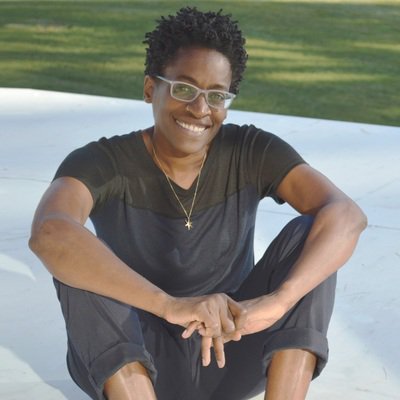
Woodson: Any kind of qualifier can be harmful because who we are is not static. Our abilities are constantly changing. What does it mean to be a struggling reader? I know if I was raised in this day and age, I would have been labeled a struggling reader. But what I know now is I was actually reading like a writer. I was reading slowly and deliberately and deconstructing language, not in the sense of looking up words in the dictionary, but understanding from context. I was constantly being compared to my sister who excelled, and it made me feel insecure. What gets translated is 'you are not as good,' and that gets translated into our whole bodies. That's where the danger lies.
Read More
Each Kindness written by Jacqueline Woodson, illustrated by E.B. Lewis 2013 Awardee
From the Notebooks of Melanin Sun by Jacqueline Woodson 1996 Awardee
I Hadn't Meant to Tell You This by Jacqueline Woodson 1995 Awardee
ALA Awards: Jacqueline Woodson wins 2018 Wilder Award
Jacqueline Woodson is the winner of the 2018 Laura Ingalls Wilder Award honoring an author or illustrator, published in the United States, whose books have made a substantial and lasting contribution to literature for children. Her numerous works include "Brown Girl Dreaming" and "After Tupac & D Foster."
"From picture books through novels for young teens to her exquisite memoir in poetry, Jacqueline Woodson has established herself as an eloquent voice in contemporary children's literature," said Wilder Award Committee Chair Rita Auerbach.
If children's literature today addresses themes of racism, sexuality, and class; if previously invisible characters have come to the fore; if different voices are now heard; if more children see themselves and others in books, look to Jacqueline Woodson as a prime-mover. For over 25 years, in elegant poetry and prose, she has courageously explored issues once ignored and nurtured her readers' self-esteem and empathy.
Read More
ALA Awards: Larry Dane Brimner wins 2018 Sibert Medal
Larry Dane Brimner, author of "Twelve Days in May: Freedom Ride 1961," was named the winner of the 2018 Robert F. Sibert Medal for the most distinguished informational book for children published in 2017.
"Twelve Days in May: Freedom Ride 1961" is published by Calkins Creek, an imprint of Highlights. In 1961 on the seventh anniversary of the Brown vs. Board of Education ruling, 13 freedom riders boarded two buses in Washington D.C. bound for New Orleans. The riders were willing to risk their lives to challenge illegal Jim Crow practices on interstate buses and in bus terminals.
"Spare text, bold graphics and arresting photos combine to take young readers on a 12-day journey through the Jim Crow American south of 1961," said Sibert Medal Committee Chair Tali Balas.
Read More
We Are One: The Story of Bayard Rustin by Larry Dane Brimner 2008 Awardee
Birmingham Sunday by Larry Dane Brimner 2011 Awardee
ALA Awards: Eloise Greenfield is the 2018 recipient of the Coretta Scott King-Virginia Hamilton Award for Lifetime Achievement
"Eloise Greenfield is a trailblazer whose extraordinary books of poetry and prose have influenced many and continue to resonate with children today. Her rich body of work inspires and enriches readers," said Award Committee Chair Deborah D. Taylor.
Early in life, [Greenfield] discovered a love of reading and writing and realized there were few books that showed the fullness of African American life. She published her first book in 1972 and went on to write and publish more than 40 books. From "Honey, I Love" to "The Great Migration," this multiple award-winning author has captivated audiences through the years.
Read More
Paul Robeson by Eloise Greenfield 1976 Awardee
Pierre TechnoKids to compete in World Championships
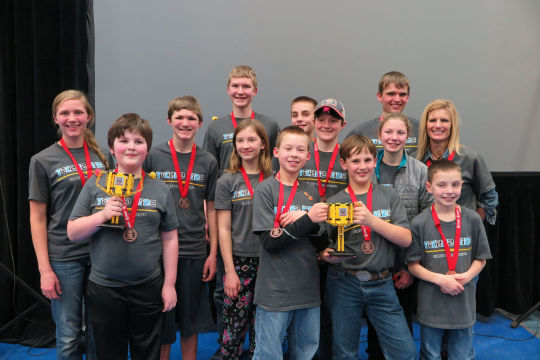
The Pierre Techno Kids, who compete in the FIRST LEGO League, will see competition at the FIRST Tech Challenge World Championships in Detroit on April 25-28. The teams create LEGO Mindstorms robots to help them complete these tasks. Teams compete in four areas, including a robot game that sees the robot complete a series of tasks in two and a half minutes without outside assistance. The other three area include core values robot design, and project.
The real world problem that teams were given this year was hydrodynamics, or in other words, the finding, transporting and use of water. According to Techno Kids coach Carolyn Ryckman, the team was inspired by the book "The Long Walk to Water" by Linda Sue Park, in which a girl in Sudan spends eight hours a day carrying water for her family. The solution that the Techno Kids developed was using drones to carry water to people in need.
Read More
Newbery Medal-winner Linda Sue Park to speak at Bridgewater College
Children's and young adult literature author Linda Sue Park, winner of the 2002 Newbery Medal for her book, A Single Shard, will present a public lecture at 7:30 p.m. Wednesday, Feb. 21, in the Carter Center for Worship and Music at Bridgewater College.
She has written numerous picture books and novels for children and young adults, including the Publishers Weekly Best Books of the Year, When My Name Was Keoko, and Project Mulberry, which won the Chicago Tribune Young Adult Fiction Prize. Her most-recent titles are A Long Walk to Water (a novel from Clarion Books) that received the Jane Addams Children's Book Award; and more.
Read More
A Long Walk to Water: Based on a True Story by Linda Sue Park 2011 Awardee
When My Name Was Keoko by Linda Sue Park 2003 Awardee
LI exhibitions shine light on black experience, artistry
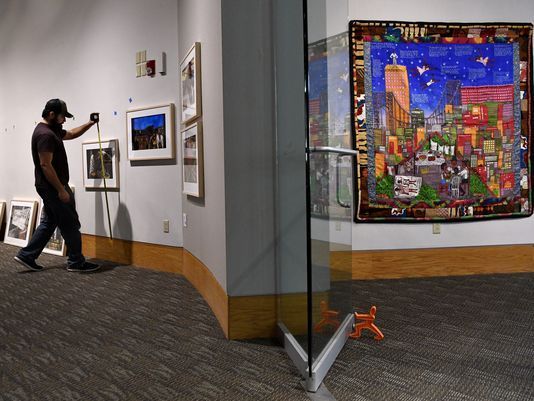
Hofstra University is showcasing the work of artist Romare Bearden in a series titled 'Odysseus Suite.' Patchogue Arts Council is exhibiting the works of more than a dozen African-American artists.
The works are varied and include a detailed quilt by artist Faith Ringgold titled, "Tar Beach," which depicts a black family on the roof of their Brooklyn apartment on a summer night.
Read More
Aunt Harriet's Underground Railroad in the Sky by Faith Ringgold 1993 Awardee
Civil rights icon Ruby Bridges inspires thousands with speech on values
Ruby Bridges, the "youngest foot soldier" of the Civil Rights movement, delivered the Presidential Colloquium to a crowd of over 2,000 people at Smith College on Friday, Feb. 2.
Dana Warren, a fourth grader from Westhampton Elementary School, was responsible for Bridges speaking at the college. After reading Bridges' autobiography "Through My Eyes," in the second grade, Warren was immediately inspired by Bridges' story and what it represented.
Hoping that others would be able to hear Bridges' message, Warren wrote to Smith College President Kathleen McCartney asking her to "help achieve her dream."
After listening to the speech she helped organize, Warren said "it was "amazing" to meet Ruby Bridges, and hear her story "literally through her eyes."
Read More
Through My Eyes by Ruby Bridges 2000 Awardee
Start the year of the dog off with young adult social justice books

Lion Island by Margarita Engle
Through a series of poems, Engle tells the story of Antonio Chuffat, an Afro-Cuban whose youth was shaped by the struggle for independence and freedom of expression, and specifically against forced labor.
Margarita's verse novel elegantly sketches the young protagonists' personalities, fears and dreams. Antonio is entrusted to carry dangerous messages; indeed, his father hides runaways among his cuadrillas (work gangs). Yet his friend, Wing, runs away to take up guns with the Resistance. Fan had to run away from home to take her singing role and her father takes a local woman as a wife. The young people ponder their cultural identities, especially when lacking opportunities to further their Chinese or other language studies.
Margarita's compelling story inspires further research, and she ends by including sources for young people and adults. To place the experiences of nineteenth century Chinese diaspora in this broader context complicates yet also makes Asian American identity more whole.
Read More
Silver People: Voices from the Panama Canal by Margarita Engle 2015 Awardee
The Surrender Tree: Poems of Cuba's Struggle for Freedom by Margarita Engle 2009 Awardee
'Love' and other best children's and YA books to read this month
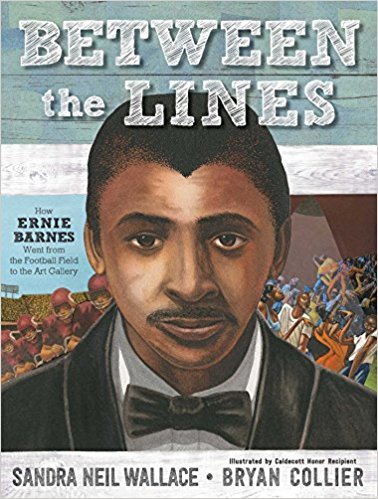
Go ahead and judge Between the Lines (Simon & Schuster, ages 4 to 8) by its wonderful cover. Rightfully front and center is the picture book's subject - football player turned artist Ernie Barnes - handsomely wrought by illustrator Bryan Collier. Barnes is flanked by a football scene on one side and by Collier's version of "Sugar Shack," Barnes's most famous painting, on the other.
Read More
Martin's Big Words: The Life of Dr. Martin Luther King, Jr. written by Doreen Rappaport with artwork by Bryan Collier 2002 Awardee
Dear Match Book: Poems for Young Readers
Stretch the Rules: Once you've played with some words you'll want to master some forms.
And, for a more immediate though no less complex wordplay, turn to Paul Fleischman's exquisite book of read-aloud verse, "Joyful Noise." The insect-themed compositions unfold in rich counterpoint meant for two readers. After exchanging lines of verse while you are apart, I imagine that it will be poetic to hear your voices together.
Read More
Seedfolks by Paul Fleischman 1998 Awardee
A$AP Rocky, Kelvin Harrison Jr., and Director Anthony Mandler on Their Sundance Drama 'Monster'

One of the many films to world premiere at this year's Sundance Film Festival was Anthony Mandler's feature film debut, Monster. Adapted from the best-selling novel of the same name by Walter Dean Myers, the film is about a 17 year old honors student and aspiring filmmaker Steve Harmon (Kelvin Harrison Jr.) who ends up being charged with a crime he says he didn't commit. As we jump back and forth between the trial and the time that led him to jail, the audience is asked to decide what kind of man he is - a young black criminal, assumed guilty and labeled a monster, or an innocent?
Read More
Now Is Your Time! The African-American Struggle for Freedom by Walter Dean Myers 1992 Awardee
Patrol: An American Soldier in Vietnam by Walter Dean Myers 2003 Awardee
Unit 4 schools celebrating National African American Parent Involvement Day
Students in Ms. P's class will be studying the work of author/illustrator R. Gregory Christie and creating their own illustrations inspired by his unique style.
Read More
The Book Itch: Freedom, Truth & Harlem's Greatest Bookstore by Vaunda Micheaux Nelson, illustrated by R. Gregory Christie 2016 Awardee
Activism Anthologies and Guides for Young Readers
While activism isn't new, the methods and means available to today's citizens certainly are, as well as the platforms afforded to historically underrepresented people. Here we round up a list of recent and forthcoming titles that bring to the forefront progressive issues, individuals who are fighting for equal rights, and strategy guides for politically motivated young readers.
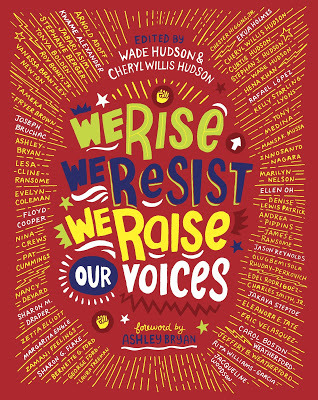
We Rise, We Resist, We Raise Our Voices: Words and Images of Hope Ed. by Cheryl Willis Hudson and Wade Hudson Fifty influential children's book creators, including Jason Reynolds, Jacqueline Woodson, and Kwame Alexander, offer their own responses to the following prompt: "In this divisive world, what shall we tell our children?" via poems, letters, essays, and art.
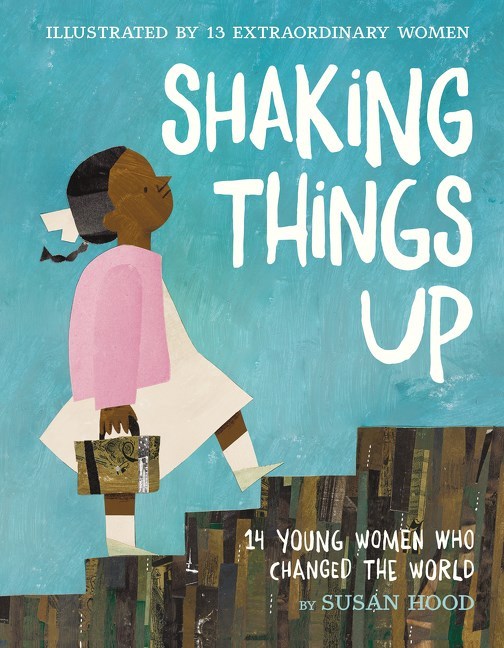
Shaking Things Up: 14 Women Who Changed the World Ed. by Susan Hood (Jan. 3, HarperCollins). This picture book tells the stories of influential women through history, from Malala Yousafzai to Pura Belpré, and features stories and illustrations by all-female contributors, including Selina Alko, Sophie Blackall, LeUyen Pham, Melissa Sweet, and many more.
Read More
Brave Girl: Clara and the Shirtwaist Makers' Strike of 1909, written by Michelle Markel and illustrated by Melissa Sweet 2014 Awardee
Black History Month: Acclaimed picture book author to talk about segregation, social justice, writing
To mark Black History Month, acclaimed picture book author Carole Boston Weatherford will participate in a couple of free and family-friendly events in the Triangle.

Weatherford, an English professor at Fayetteville State University, has won numerous awards for her picture books, including "Freedom in Congo Square," which was a Caldecott Honor Book last year, and is a New York Times best-selling author. Other books include "Voice of Freedom: Fannie Lou Hamer, Spirit of the Civil Rights Movement," "Schomburg: The Man Who Built a Library," "In Your Hands" and "The Legendary Miss Lena Horne."
"Segregation, Social Justice and Civil Rights:" how our history and cultural evolution is shaped by slavery, segregation and social justice.
"Poetry and All That Jazz:" Celebrate the poetry of music and musicians, from North Carolina-born jazz saxophonist John Coltrane to legendary entertainer and activist Lena Horne.
Read More
Birmingham, 1963 by Carole Boston Weatherford 2008 Awardee
How you can celebrate Black History Month...
Every year, the Association for the Study of African American Life and History selects a theme for Black History Month. This year, the theme, African Americans in Times of War, is meant to commemorate the end of World War I.
GIVE A CHILD A GIFT OF A BLACK HISTORY BOOK. One of my favorites, Preaching to the Chickens: The Story of Young John Lewis, by Jabari Asim, celebrates a contemporary hero, Congressman John Lewis.
Another, Minty: The Story of a Young Harriet Tubman by Alan Schroeder, tells the story of the Maryland icon who helped dozens of enslaved people escape through the Underground Railroad (legend says it is hundreds, but at Harriet Tubman Museum (operated by the National Park Service in Church Creek, Maryland) researchers say some of the estimates are too high.
The Youngest Marcher: The Story of Audrey Faye Hendricks, a Young Civil Rights Activist by Cynthia Levinson will motivate young people to activism.
Sit In: How Four Friends Stood Up By Sitting Down by Andrea Davis Pinkney and Brian Pinkney will also motivate young people to take on activist roles.
Read More
Sit-In: How Four Friends Stood Up by Sitting Down by Andrea Davis Pinkney, illustrated by Brian Pinkney 2011 Awardee
Sojourner Truth's Step-Stomp Stride, by Andrea Davis Pinkney & Brian Pinkney 2010 Awardee
We've Got a Job: The 1963 Birmingham Children's March by Cynthia Levinson 2013 Awardee
We Shall Overcome: The Story of a Song written by Debbie Levy, illustrated by Vanessa Brantley-Newton 2014 Awardee
Abilene children's center making history with 'Our Voice' exhibition
An exhibit three years in the making opens Thursday at the National Center for Children's Illustrated Literature, 102 Cedar St.
"Our Voice: Celebrating the Coretta Scott King Illustrator Awards" will run through at least May 19, according to Sujata Shahane, director of education and exhibitions programming at the NCCIL.
The Coretta Scott King Book Awards have been given annually since 1969 to African-American authors and illustrators of books for children and young adults for demonstrating African-American culture and values.
Of the 108 illustrated books that have been honored for their illustrations, the exhibit has art, either original or official reproductions, from 100 of them. Of the 38 illustrators who have been honored with the award, the exhibit has work from 33 of them.
"I Too Am American," by Bryan Collier, is part of the "Our Voice" exhibition
The art runs the gamut of oil-based and water-based painted works, computer-generated works, art that is on ceramic tiles and even an illustrated quilt from Faith Ringgold. One of the exhibit's prized pieces is work from South African photographer Peter Magubane, Nelson Mandela's personal photographer.
Many of the exhibits are interactive. Patrons can scan a barcode on works and hear the artists talk about their works.
In addition to the exhibit, there will be presentations by artists Javanka Steptoe and Jerry Pinkney on March 20 and April 5, respectively. Claudette McLinn, chairman of the Coretta Scott King Book Awards Committee for 2017-2019, will be speaking at the NCCIL on March 5.
Read More
Martin's Big Words: The Life of Dr. Martin Luther King, Jr. written by Doreen Rappaport with artwork by Bryan Collier 2002 Awardee
Aunt Harriet's Underground Railroad in the Sky by Faith Ringgold 1993 Awardee
Hot Day on Abbott Avenue by Karen English, with collage art of Javaka Steptoe 2005 Awardee
Why Christopher Paul Curtis writes best from a place of fear
Curtis: I find the writing goes best for me if I try to replicate as much as possible all of the circumstances of my first book, The Watsons Go to Birmingham - 1963. I was writing from a point of fear back in 1994 and that seems to be the place I find my best work. I was afraid I'd taken a year off work to write a book and wasn't going to be able to do it, I feared the loss of income for a year, I feared how it would feel to be unsuccessful at having the chance to try to "follow my dream" and finding out a nightmare was at the end of the journey.
Read More
Elijah of Buxton by Christopher Paul Curtis 2008 Awardee
The Watsons Go to Birmingham - 1963 by Christopher Paul Curtis 1996 Awardee
Children's production 'Roll of Thunder' doesn't shy away from America's history of racism
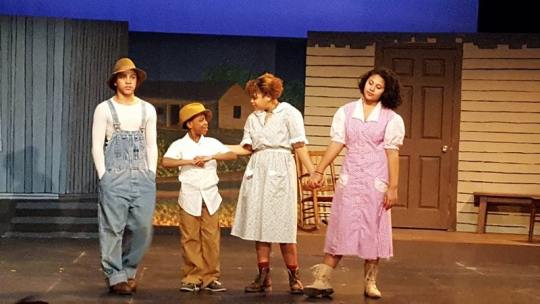
Mildred D. Taylor's Roll of Thunder, Hear My Cry was published in 1976, a novel for young adults during an era when educators were embracing the idea that children's books could and should tackle life's serious realities. Books like Roll of Thunder - and The Outsiders, and Bridge to Terabithia - could help kids understand, and grow.
It's a complex story of people who are striving to do right in an impossible situation, and a new SteppingStone Theatre production directed by Kory LaQuess Pullam ensures that every member of the audience appreciates the stakes. As the play opens, opposing crowds of black and white actors stalk forward to confront each other, chanting, "This is my world! My world! My world!"
Read More
The Well by Mildred D. Taylor 1996 Awardee
Let the Circle Be Unbroken by Mildred D. Taylor 1982 Awardee
Roll of Thunder, Hear My Cry by Mildred D. Taylor 1977 Awardee
Song of the Trees by Mildred D. Taylor 1976 Awardee
McNay showcases African American art
The exhibits include "Something to Say: The McNay Presents 100 years of African American Art" and "30 Americans: Rubell Family Collection" and will continue until May 6. "Something to Say" is the first major survey of modern and contemporary African American art to be presented at the McNay. The exhibition juxtaposes works from the pioneering collection of Harmon and Harriet Kelley with loans from the collections of Guillermo Nicolas and Jim Foster, John and Freda Facey and the McNay.
The concept is to provide visitors with the opportunity to reflect on a range of African American experiences and examine how artists have expressed personal, political and racial identity over 100 years.
Also included in the exhibit is Benny Andrews' "Sexism," the seventh in the McNay's series of AT&T Lobby instillations. Between 1970 and 1975, Benny Andrews created six monumental paintings as part of his Bicentennial series, in response to the United States Bicentennial plans in 1976.
McNay hosts the fourth work in the series, "Sexism," 1973, explores oppression of women. The works are classified as provocative and complex in its contemplation of power among genders.
Read More
Delivering Justice: W. W. Law and the Fight for Civil Rights, written by Jim Haskins, illustrated by Benny Andrews 2006 Awardee
Read all about it: Black History Month books for kids
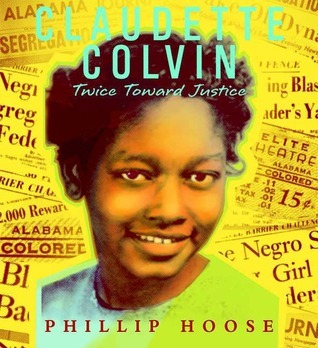
"Claudette Colvin: Twice Toward Justice" by Phillip Hoose (Farrar, Strauss and Giroux 2009) is an excellent choice for teens. Hoose tells the story of Colvin, who as a teenager refused to give up her seat for a white passenger on a city bus in Montgomery, Alabama, and was arrested. This was nine months before Rosa Parks did the same thing.
While Parks was celebrated for her disobedience, Colvin was not. Colvin chose to challenge the segregation law in court, but was found guilty, leaving her with a criminal record. She became one of the plaintiffs in the Browder vs. Gayle lawsuit that eventually desegregated Montgomery's buses.
The message of this book isn't to detract from Rosa Parks' legacy, but to recognize another brave woman who fought for justice and equality. Hoose's writing is based on several personal interviews with Colvin, and included within the book are black-and-white photos from the time period and copies of documents and newspaper articles. "Claudette Colvin: Twice Toward Justice" was the winner of the 2009 National Book Award.
Read More
Hey, Little Ant by Phillip and Hannah Hoose 1999 Awardee
Claudette Colvin by Phillip Hoose 2010 Awardee
---
The Jane Addams Children's Book Award annually recognizes children's books of literary and aesthetic excellence that effectively engage children in thinking about peace, social justice, global community, and equity for all people.
Read more about the 2017 Awards.
0 notes
Photo

Visit to the Chantilly Science Cosmos Center. We offer a variety of Lego classes, camps and after school programs for kids. Science Cosmos is a fun learning program, where children develop an interest in science, technology and engineering.
Website: https://sciencecosmos.com/
#Children’s Education Franchise#Kids Enrichment Franchise#Science Cosmos Franchise#Ellicott City Birthday Parties#South Riding Lego Robotics#Affordable Kids Franchise#Ellicott City Lego Robotics#Kids Programming Classes
0 notes
Photo

A kids enrichment and education franchise offering can be made by Science Cosmos at affordable prices in a state only if we are first registered, excluded, exempted or otherwise qualified. Science Cosmos is a fun learning program, where children develop an interest in science, technology and engineering.
Visit at : https://sciencecosmos.com
0 notes
Photo

At Science Cosmos, we are dedicated to offering the best kids programming classes to learn more about science, technology & engineering. Science Cosmos is a fun learning program, where children develop an interest in science, technology and engineering.
Website: https://sciencecosmos.com/
0 notes
Photo

Visit to the South Riding Science Cosmos Center. We offer a variety of Lego robotics classes, camps and after school programs for kids. Science Cosmos is a fun learning program, where children develop an interest in science, technology and engineering.
Website: https://sciencecosmos.com/
#Summer Camps Ashburn#Summer Camps Chantilly#Science Cosmos Franchise#Lego Classes Ashburn#Aldie Summer Camps#Ellicott City Birthday Parties#Lego Robotics Camps#Kids Programming Classes#Affordable Kids Franchise
0 notes
Text
Give your child a head start by enrolling him with South Riding Lego Robotics
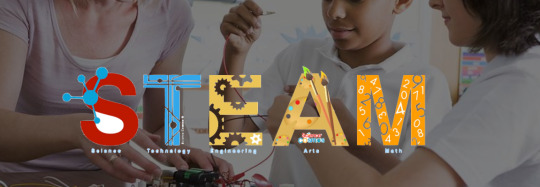
Science Cosmos is a program that makes learning fun where children develop an interest in science, technology, engineering, arts and math, the children are given Legos, Knex, electronic circuits and robots that they use to build machines and models. Everything is taught to the students in subjects like Science, technology, engineering, arts, and mathematics by using building platforms and robotics.
They also offer a complimentary program in arts cosmos. The children are involved in an age-appropriate program that is progressive. Children who join these programs do well in academics.
South Riding Summer Camps
In summer when there is no schooling the children do not know what to do. They do not have anything to keep them busy. They miss their friends and the social interactions they had during school days and also the mental challenges. To help them improve in maturity and mental growth it is better to send them to summer camps where they will meet other children and take part in a lot of activities.
If they do not join summer camps or go on a holiday there is nothing much for them to do with parents busy with their work except watch TV. When children are sent to summer camps the parents can have peace of mind that the children are in safe hands. On the other hand, children will develop positive attitudes, structure, and motivation.
Summer Camps in Ashburn
The summer camp in Ashburn is a wonderful experience. Before you send your child you can choose an adventure-themed camp or an inspiring camp. Both the camps will provide entertaining field trips and activities for children between the ages of 5 – 13. In these camps, the children will also be able to make new friendships.
The summer camp in Ashburn provides the children with a clean, active, and safe environment assisted by counselors who adopt self-esteem and a healthy lifestyle. The timing of the camp is from 9 am – 4 pm with before and after-care with a fee. All the campers have to carry lunch which is free of nuts, drink, sunscreen and sneakers daily and on water park days they have to carry a towel and swimsuit.

What does summer camp in Chantilly offer?
The summer camp at Chantilly has a knowledgeable and experienced staff that provides the children with great sports experience for the summer. Each camper is placed in an age-appropriate group for playing in indoor courts and turf fields. During the day they provide different sports and high energy games. The camp is not focused on any special sport but the children can take part in different sports and athletic activities.
The children can play soccer, kickball, flag football, dodgeball and a lot of other games. The camp is ideal for students from elementary and middle school for athletic level activities. The camp timings are from 9 am – 5 pm.
If you want to send your child to South Riding Summer Camp visit Sciencecosmos.com to find the best camp appropriate for his age.
0 notes
Text
Enroll your child in South Riding Lego Robotics to help compete in todays’ world
Science Cosmos is a program that makes learning fun. In this program they make children work with building structures and Lego to develop them for science, technology, engineering, arts, and math. Children love this as they build and discover in an environment that is fun.
Children get an opportunity to build machines and structures using robots, Lego, Knex, electronic circuits and more. They use applications of game designs which utilize Minecraft and also have a complementary arts program. Success at Science Cosmos may be a stepping ladder to competitive and academic programs.
Kids Summer Camps
Science Cosmos organizes summer camps for kids that are designed for learning. The kids have a lovely time discovering and building and at the same time learning the concepts of Engineering, Technology, and Science. Camp themes are provided to children of ages 4 – 14. They have a wide range of topics on camp lessons to spark the imagination of your child.

You can go through the different camp lesson topics which are provided under the camp theme category. When you enroll your child for a camp they provide you with the camp schedules of the center. They have a wide range of topics which are arranged under 3 themes of camp. The themes may be changed each week. To keep the children involved the lesson topic for the week will be chosen by the staff at the camp location.
South Riding Summer Camps
During summer the children get holidays and there is nothing to keep them occupied. During holidays the children have no mental challenges, so they will not have anything to help in their mental growth and maturity. This is the time that Science Cosmos has camps for kids. In these camps, they meet their peers and join in structure building and assembling Lego to build robots.

Camps will give kids motivation, positive attitudes, and structure building to prove themselves better than the others. They will wait for camps when they will meet new friends.
Kids enjoy themselves and develop new experiences and memories
Camps are places for fun and mental growth. Parents are not allowed at the camp. Children’s Education Franchise are given an opportunity at different things and make their own mistakes and get them corrected by counselors who are there to assist them. They will take part in different activities until they utilize all their energy. Then the counselors will provide them with Lego to start the structure building work. They have a full program laid down with different activities that the children will go through to improve themselves.

Summer camps are opportunities for kids to accomplish new things and make new friends. Children will be given the possibility to design, swim, play and participate in other activities. They will also meet new role models. Aldie Summer Camps help children to be proactive during holidays. Camps are designed to help children in their mental growth.
Conclusion
Do you want to send your children to South Riding Summer Camps? Then visit Sciencecosmos.com to find the camp closest to your location.

0 notes